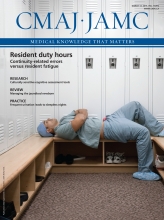Cannabinoid hyperemesis syndrome (CHS) is a new and underrecognized clinical syndrome
Cannabis is the most widely used illicit drug in Canada, with 42% of adults reporting usage during their lifetime.1 Cannabinoid hyperemesis syndrome (CHS) is characterized by recurrent episodes of intractable nausea and vomiting in patients who have been using cannabis daily for years (Box 1).2–4 Patients with CHS may have numerous visits with their physician before diagnosis, which highlights the underrecognition of this syndrome.5
Features of cannabinoid hyperemesis syndrome2,3
Current, heavy cannabis use
Abdominal pain, epigastric or periumbilical
Recurrent episodes of severe nausea and intractable vomiting
Compulsive bathing with symptom relief
Resolution of symptoms with cannabis cessation
Failure of standard antiemetics to resolve nausea and vomiting
CHS is characterized by the triad of long-term cannabis abuse, cyclic episodes of nausea and vomiting, and compulsive bathing
Patients with CHS have a history of daily use of natural or synthetic cannabis over a period of years.5 They experience incapacitating vomiting that sometimes occurs more than 20 times per day and can last 24–28 hours.2 Patients report taking numerous hot showers or baths with relief of symptoms, a learned behaviour termed compulsive bathing, which is pathognomonic for CHS.2
The differential diagnosis for CHS is large
Life-threatening causes of nausea and vomiting, such as intestinal obstruction or perforation and pancreatitis, must be ruled out.2,5 Cannabinoid hyperemesis syndrome is most often confused with cyclic vomiting syndrome. Patients with cyclic vomiting syndrome are more likely to have a history of psychiatric illness and a personal or family history of migraines.2
The exact mechanism of hyperemesis associated with long-term cannabis use is unknown
Tetrahydrocannabinol (THC), the active compound in cannabis, binds to cannabinoid receptors (CB1 and CB2).5 Antiemetic properties are mediated by activation of CB1 in the hypothalamus, and nausea and vomiting properties by activation of CB1 in the enteric nervous system. Hyperemesis in heavy cannabis users is thought to occur because of the accumulation of THC in fatty tissues, which leads to enteric stimulation that overrides the effects of the central nervous system.2,5
Treatment is supportive, and remission requires abstinence from cannabis use
Permanent remission of CHS requires cessation of cannabis use.4 Standard antiemetics fail to relieve vomiting, but relief has been reported with lorazepam and haloperidol.2 Case reports of acute renal failure secondary to CHS have been noted, all of which resolved with intravenous hydration.6
Footnotes
Competing interests: None declared.
This article has been peer reviewed.








